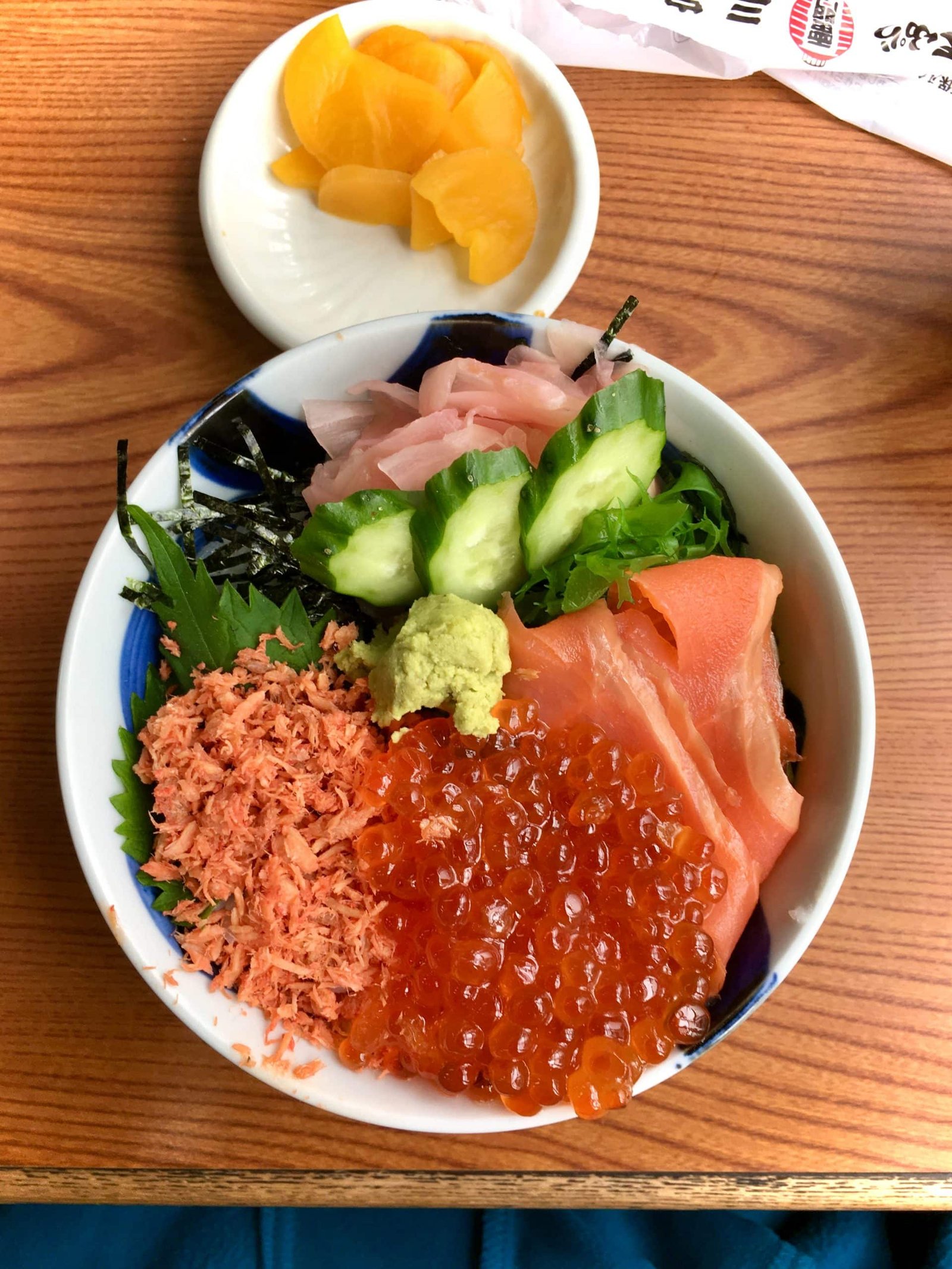After more than 80 years Tokyo’s famous Tsukiji fish market was closed in 2018.
The inner fish auction market moved to another location, the new Toyosu market. However the many eateries and food stalls (about 400!) around the closed market remain at the very same place.
So is it still worth going to the Tsukiji fish market, you might ask yourself?
Absolutely.
Especially if you are looking for a fresh fish and seafood breakfast or early sushi and sashimi lunch.
The streets in and around the Tsukiji fish market get very crowded from 10am onwards until most shops close after 2pm, but don’t let that scare you off.
If you are in for excellent fatty tuna toro belly and the freshest scallops ever, this is the place to be. A bunch of eateries are famous for serving the freshest sushi for very affordable prices.
You might have seen a couple of episodes before of famous TV celebrities visiting the Tsukiji fish market in search of the best food.
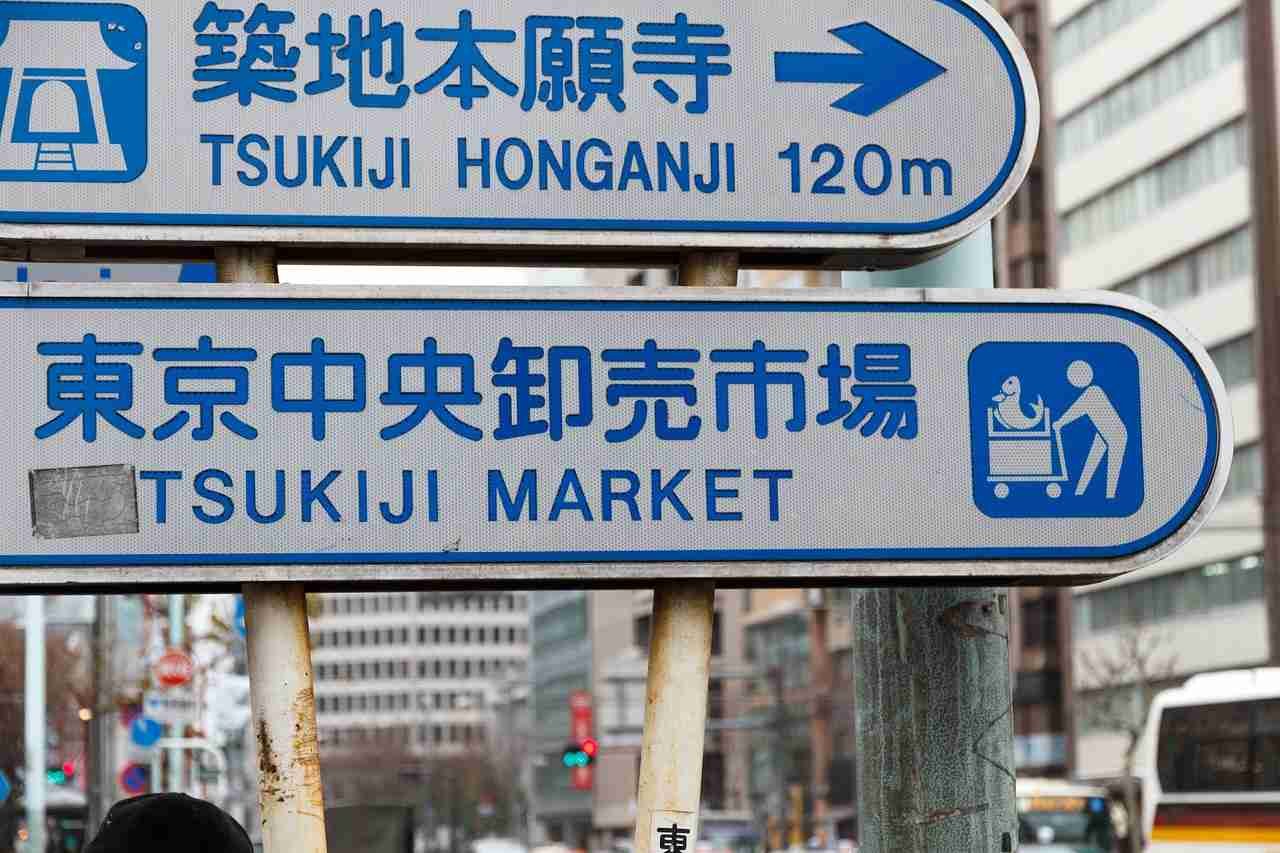
Breakfast at Tsukiji fish market
We are staying at the Oakwood Premier Tokyo right next to Tokyo Station.
This morning we skip breakfast and decide to head to the Tsukiji fish market.
Fresh tuna is what we want.
The subway takes us where we need to be, our stop is the Tsukijishijo Station.
And straight away the mouthwatering smells in the street greet us. It is quite crowded already even though it is only 9am. Lots of stalls are surrounded by groups of people recording how a huge chunk of tuna is sliced up.
And we get it right away, because it is very spectacular to watch.
The tuna looks juicy and so fresh.
We decide to walk around and just look at what each of these stalls in this street sells. Cardboard and plastic plates filled with fresh sashimi and other delicious snacks, each accompanied by a small paper informing you of the price.

Street food
But we are here for fresh tuna.
So how do we choose the right food stall?
There are so many here at the Tsukiji fish market! Honestly, we think that they are all quite alright. So we use our rule of thumb, go stand in line where there is a big crowd.
After queuing for about 10 minutes we are able to lay our hands on a splendid looking tower of freshly sliced tuna.
In total we pay 2200 JPY (15 USD) for this lovely portion of meaty looking fresh tuna, which is a very reasonable price if you look at the prices at other sashimi stalls that are much higher.
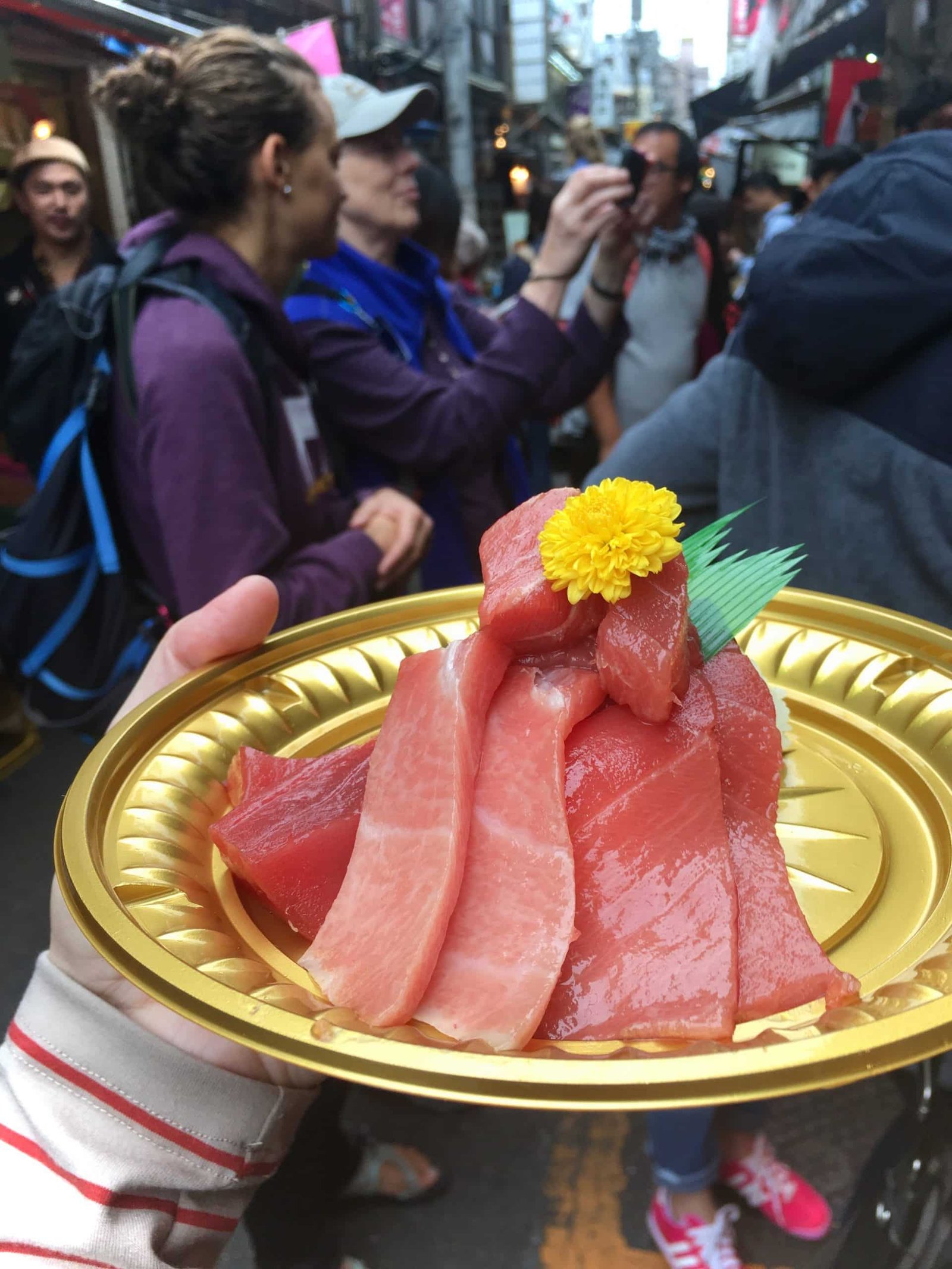
We get a couple of chopsticks, paper napkins and some soy sauce to dip the tuna in. We go stand in a less crowded corner of the street and dig in.
Oh man, this tuna is the best we have ever tasted! Hands down, this stuff is so good.
The meat is so soft and smooth. It is fatty and rich, oily and so velvety. It is like butter, you bite right through it.
Just wow.
Ditch that soy sauce, it would be such a waste to dip that gorgeous tuna meat in it. This tower of tuna is quite filling actually.
We decide to stay a little longer and just walk around. Look at all the food that is for sale, enjoy the lovely weather and appetizing smells.
June can’t resist a couple of delicious looking skewers: one with grilled eel and another one with fish liver.
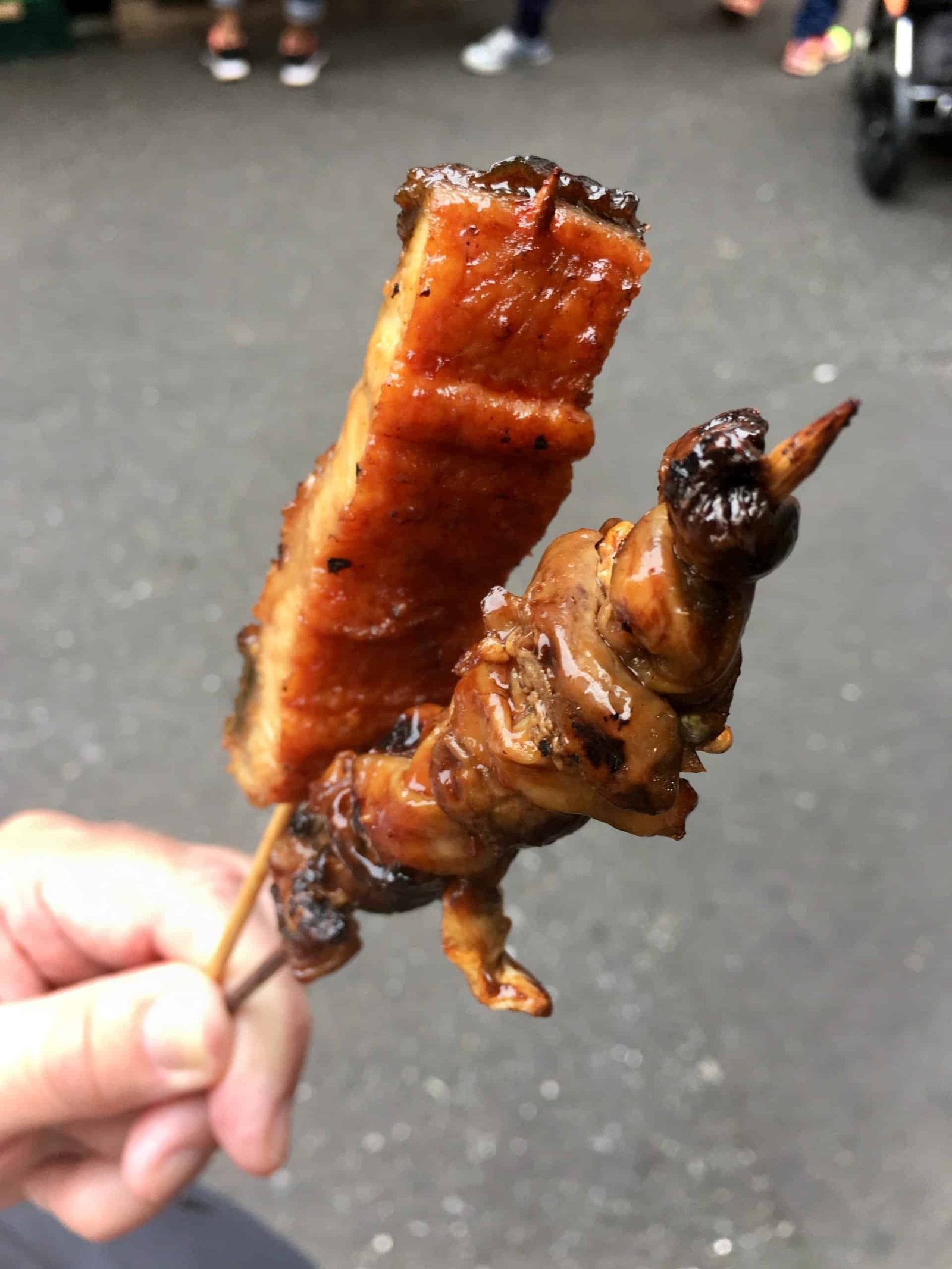
It is approaching lunchtime now and the streets are visibly getting more and more crowded.
Is the Tsukiji fish market worth the trip?
Most definitely.
Best restaurants at Tsukiji fish market
There are many restaurants at Tsukiji fish market that offer delicious seafood dishes, but some of them stand out for their popularity, quality or uniqueness.
It is hard to choose just a handful of good food places here that offer as good as everything: from drinks and soups to fresh fish, wagyu, potato croquettes, fruits and dessert.
So we decided to only list 10 of our favorite shops, stalls and restaurants where you can eat delicious savory meals and bites such as ramen, seafood, sushi, sashimi and stews.
Here are some of the best restaurants at Tsukiji Fish Market that you should try!
1. Wakaba
Located in the Tsukiji outer market in Tokyo, Wakaba has been serving its no-nonsense ramen for over 60 years. This humble eatery is a favorite among both local fishermen and curious tourists. The queue often stretches about 10 deep with overseas customers eager to try their flavorful bowls.
The signature dish at Wakaba is their classic “chuka-soba” ramen (900 JPY – about 6 USD). This comforting bowl features thin noodles, a slice of chashu pork and spring onions in a soy sauce-based soup. The noodles are intentionally thin to ensure quick service to turn tables, so diners need to eat fast before they become too soggy.
A bowl of Wakaba’s ramen—a true taste of tradition and local flavor!
2. Aji-no-Hamato
Aji-no-Hamato has been in business since 1925 and is a fish specialist.
This place is renowned for its delectable seafood treats. The most popular one is the deep fried nerimono fish cakes of shrimp pasta and corn on a stick (420 JYP – 3 USD).
Locals prefer to purchase food to take away. Do the same and stroll around the bustling market, savoring these treats on a stick as you explore.
3. Onigiri Marutoyo
Marutoyo is celebrated for its delightful stuffed bakudan onigiri rice balls (300 JPY – 2 USD).
Unlike the typical onigiri found in convenience stores, this one is truly exceptional.
Inside these rice balls you’ll discover an array of stuffings, creating a luxurious and unique flavor. Each reflects the spirit of Tsukiji: soft boiled egg, roasted fatty mackerel, shiokara (salted fish innards), nintama miso, oyster, octopus or clams.
Don’t expect dainty bites here. Marutoyo’s onigiri come in one size only: large.
The sushi with fresh salmon or tuna here is also very delicious (324 JPY – 2,2 USD).
4. Kakigoya Tsukiji Shokudo
This restaurant is renowned for its delectable seafood!
You can sit down for a fresh seafood meal inside. The gangan yaki is popular: a combination of oysters, clams, and scallops cooked in a metal container.
However if you want to eat a small bite, Kakigoya has a small outdoor stall where they prepare steamed oysters and grilled scallops to order. Giant scallops are cooked in a delightful blend of butter, soy sauce, and sake (600 JPY – USD). You can also eat raw, steamed or fried Japanese oysters, a mouthwatering experience for visitors.
5. Okame
Okame is a small sushi bar where you eat sushi standing up.
This place is always bustling with locals and tourists for a good reason. The nigiri (individual pieces of sushi) are reasonably priced at 100 to 400 JPY (0,70 to 3 USD). However ordering a set will give you more value for your money. For approximately 1,500 JPY (10 USD) you can enjoy a delightful selection of fresh sushi, topped with scallops, horse mackerel, omelette, salmon roe and shrimp.
6. Miyake Suisan
Miyake Suisan is a seafood shop in Tsukiji fish market where people go to indulge in some of the freshest sashimi.
Their assortment comes with soy sauce and wasabi and includes a variety of delectable options such as salmon, octopus, tuna, hamachi and scallops.
Salmon is a classic choice with its rich flavor and buttery texture (500 JPY – 3,30 USD). Also try the scallop sashimi, so sweet and succulent (500 JPY – 3,30 USD).
7. Tsukiji Unagi Shokudo
Tsukiji Unagi Shokudo is a specialty store that is renowned for its exquisite unagi freshwater eel, for a very reasonable price.
Combo Jyu is a flavorful combination of rice and grilled unagi, served in a bowl. Or go for a small bite and order a skewer of grilled eel to take away (300 JPY – 2 USD). The grilled scallops o n a stick are also delicious (300 JPY – 2 USD).
8. Maguroya Kurogin
At Maguroya Kurogin, you can witness the skilled chefs expertly preparing your chosen cuts of tuna, transforming them into gorgeous dishes. The freshness combined with flavor that captivate at first glance, creates a luxurious dining experience for all tuna aficionados.
It is a haven for tuna enthusiasts. Kurogin’s fresh tuna sushi roll (1100 JPY – 8 USD) is one of the most popular treats to try here.
Maguroya Kurogin is not cheap, but people just love the quality, freshness and flavor of the fish served here.
9. Kitsuneya
Kitsuneya is one of the most popular restaurants in the outer Tsukiji fish market, so be prepared to queue and wait for a long time for a beef stew rice bowl!
This place offers some delightful specialty dishes. Horumon-ni for example: a steaming bowl of stewed bite-sized beef or pork intestines mixed with vegetables and simmered in miso or soy sauce broth (700 JPY – 5 USD).
Not an offal fan? Go for the beef stew rice bowl. The beef is cooked with soy sauce and miso until it falls apart and as a result is so super soft and smooth (800 JPY – 5,40 USD).
10. Saito Suisan
Saito Suisan is another fish shop that offers some delightful fresh seafood options.
Sashimi of cours,e but all sea urchin and raw oysters.
Saito is most famous for its fresh, creamy raw oysters that can be enjoyed year-round. Prices vary between 300 and 400 JPY per oyster (2 to 3 USD).
Sea urchin, also known as uni, is a delicacy that divides opinions. Some people adore its rich, briny flavor and creamy texture, while others find it an acquired taste. Give fresh sea urchin a try here at Saito Suisan (1500 JPY – 10 USD).
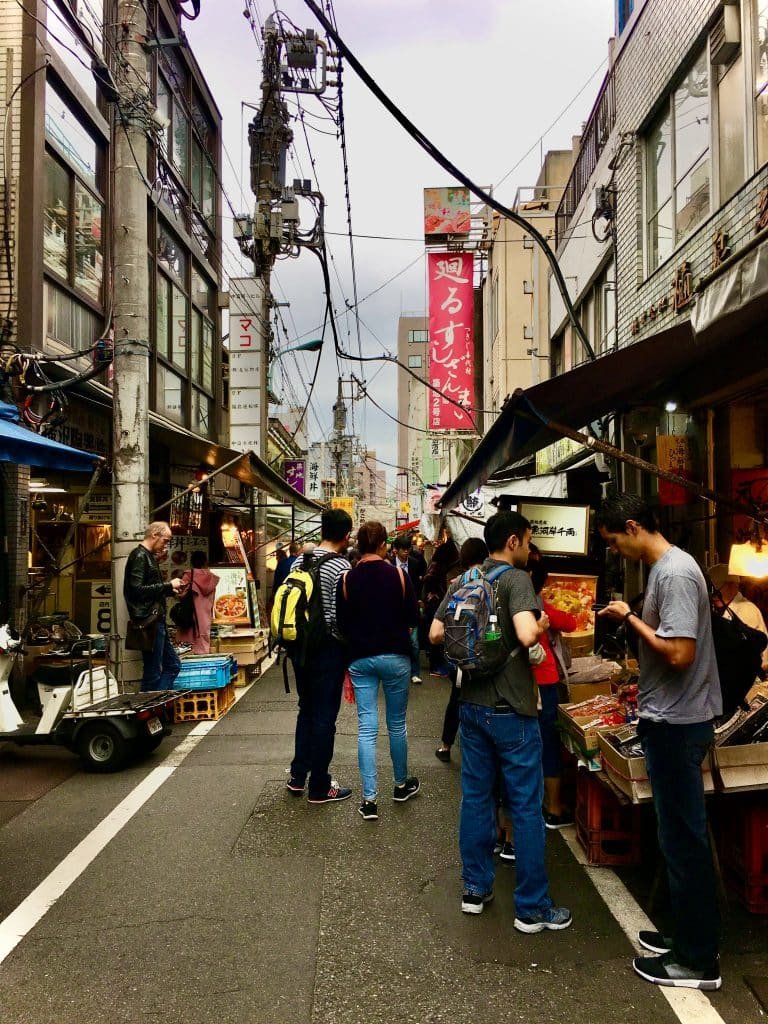
Tsukiji fish market best time to visit
Most of the shops and restaurants at Tsukiji fish market are typically open in the early morning (some even as early as 5 to 6 am) and most of them also close in the early afternoon around 2pm, after the lunch rush.
Our recommendation?
Get there early in the morning for breakfast!
Lots of shops and restaurants are closed on Sundays and Wednesdays, as well as on national holidays. It gets very crowded on Saturdays so that is also a day to avoid visiting the Tsukiji fish market.
We recommend to visit the Tsukiji fish market on Monday, Tuesday, Thursday and Friday.
To be absolutely sure that you visit on a good day, check the official website for the latest information on the opening hours and closed days. You can also find a guide map and access information on the website.
Cash or card?
Although technology is no problem in Japan, cash is still king.
Same here at the Tsukiji fish market: lots of shops and food stalls only accept cash. Some accept credit cards, not many. Paying with your Pasmo or Suica card is not possible though.
It is becoming more common for businesses in Tokyo to accept cards, especially at popular tourist spots like Tsukiji fish market. However we recommend having cash as a backup, just in case.
So come prepared and bring some cash to pay for your little treats and bites!
Restrooms
Most restaurants and food stalls at the Tsukiji fish market don’t have restrooms for customers.
When nature calls, your best bet is to go to the Tsukiji Uogashi shopping and food court centre in the heart of the Tsukiji neighbourhood where you can find clean and free restrooms on the 3rd floor.
Is the Tsukiji fish market a tourist trap?
In terms of money, the prices are quite decent actually.
We were somehow expecting higher prices.
There was also a healthy mix of locals and tourists, we would say.
After an hour of walking around we start to feel a little peckish and decide to go for a gorgeous rice bowl stuffed with salmon and roe at one of the many inside eateries. Another $12 fresh fish treat to gobble down!
Skip breakfast at your hotel and go for fresh sashimi, ramen soup or a rice bowl at the Tsukiji fish market instead!
